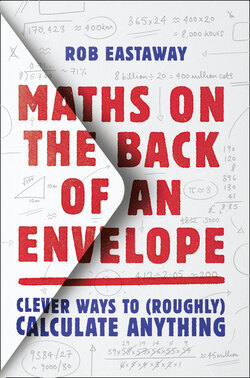Читать книгу Maths on the Back of an Envelope - Rob Eastaway - Страница 5
1 THE PERILS OF PRECISION ENVELOPES VERSUS CALCULATORS
ОглавлениеI don’t know when the backs of envelopes first became a popular place for jotting rough-and-ready calculations. Was it before or after people started to use ‘the back of a fag packet’, or in the USA, the back of a napkin?
Regardless of where the expression was first coined, the back of an envelope1 has come to symbolise any sort of rough-and-ready type of calculation that gives an indication of what the right answer will be.
It is the tool that people in business use for quickly checking the viability of a new project. Engineers use it to check if a proposed solution is likely to work. And commentators on statistics use it to help make sense of the myriad numbers that are thrown out by politicians, ‘expert’ pundits and marketers.
On a more mundane level, it’s the maths you might use every day to ensure you aren’t getting ripped off by a so-called ‘deal’ that turns out to be anything but.
It is also maths and arithmetic that can be done without needing to resort to a calculator.
But wait a minute. Maths without a calculator? To many people, this notion seems quaintly old-fashioned, or even masochistic. Why grapple with manual or mental calculations when most of us have a phone (with a calculator) readily to hand almost all of the time?
This is not an anti-calculator book. Calculators are indispensable tools that have enabled us to do in seconds what used to take minutes, hours or even days. If you need to know exactly what £31.40 × 96 is, then unless you are a savant or somebody with plenty of time on your hands, a calculator is the only sensible option for working it out. And I’m probably typical in usually having a calculator – or a spreadsheet – to hand if I’m doing my tax return, or totting up expenses after a work-related trip.
But much of the time we don’t need to know the exact answer. It’s an approximate figure that matters. The point of back-of-envelope maths is to help see the bigger picture behind numbers.
Suppose a sales team has a target of £10,000. If they report that they have sold 96 units at £31.40 each – that’s roughly:
100 × £30 = £3,000 revenue.
That’s massively short of the £10,000 target, even if the estimate is out by a few per cent.
When the government announces a £1 billion increase in health spending, is that significant? Spread between 50 million people? It won’t be exactly one billion pounds of course, nor will it be spread evenly between 50 million people, but with back-of-envelope maths, we can work out it will represent an average of something nearer to £20 (i.e. hardly anything) than £200 per person.
Of course, even these simplified calculations can be done on a calculator. But the reality is that they rarely are.
The argument: ‘Who needs to do arithmetic when we all have calculators?’ is usually a red herring. In situations where a calculation is not essential, most of us do it in our heads or on the back of an envelope, or don’t do it at all.
And there are some who use their ability to figure things mentally to their advantage. I have a friend who made his fortune as a wheeler-dealer in finance. I asked him to share some advice.
‘I have two tips for succeeding when negotiating a deal with somebody,’ he said. ‘The first is: learn how to be able to read upside down, so that you can decipher the documents of the person opposite you. And my second is: be able to do the calculations faster than they can.’
